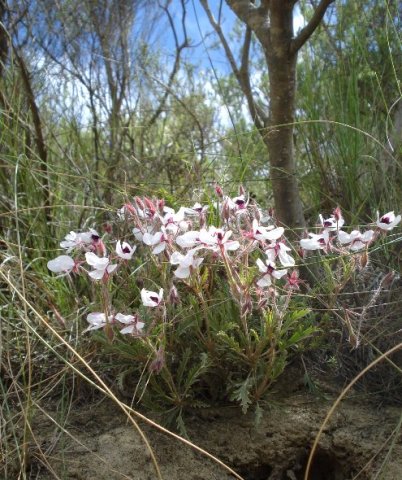Pelargonium tricolor

Author: Ivan Lätti
Photographer: Judd Kirkel Welwitch
Pelargonium tricolor, in Afrikaans commonly known as the gesiggiemalva (pansy pelargonium or little face pelargonium) and previously scientifically as P. violareum, is a sprawling to tufted shrublet reaching 20 cm to 40 cm on its own, a little taller when clambering up neighbouring supports. The rhizomatous, multistemmed plant resprouts after fire. The first few flowering seasons after fire are usually the best.
The leaves are simple, stalked, broadly lance-shaped or narrowly egg-shaped. The blades are hairy, grey-green, dark green or dull green. The margins have conspicuous, angular, deep toothing, often lighter coloured than the blades and sometimes with slight red. A couple of larger leaf lobes than teeth are sometimes present low down laterally. The leaves do not exude a strong fragrance. Leaf size varies much, generally about 45 mm long and 15 mm wide.
The species is mainly found in the east of the Western Cape, the Little Karoo on the Swartberg Mountains, the Rooiberg, the Langeberg and Outeniqua Mountains, also near Oudtshoorn and eastwards into the west of the Eastern Cape in the Langkloof, possibly as far as Humansdorp.
The habitat is stony slopes among renosterveld, fynbos and sandolien where the plants grow in sandy and loamy soils. The habitat population is deemed of least concern early in the twenty first century (Vlok and Schutte-Vlok, 2015; Moriarty, 1997; Bond and Goldblatt, 1984; iNaturalist; http://pza.sanbi.org; http://redlist.sanbi.org).

